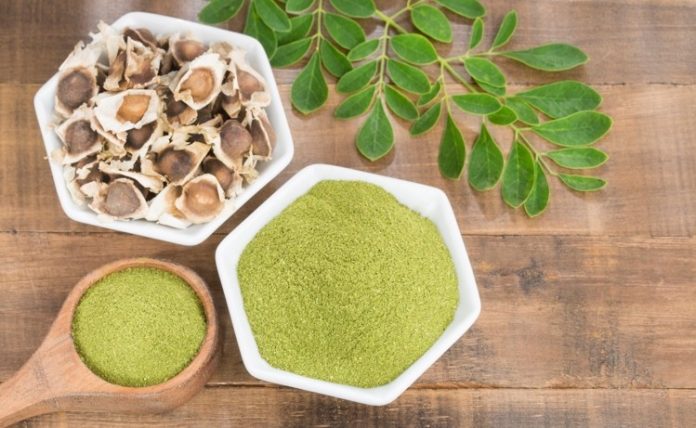Moringa is, and with good reason, named the “Miracle Tree”
It’s one of the top superfoods out there on par with avocado, salmon, quinoa, or turmeric just to name a few.
This plant’s flexibility is unparalleled considering how it can be used for survival in so many ways.
If I had to choose only one tree to grow in my backyard, that would be it.
What is Moringa?
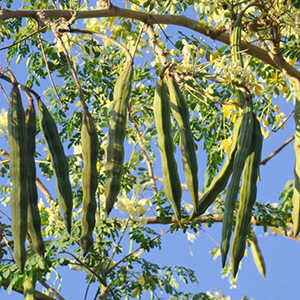
Moringa is a tree that loves arid conditions and it has been used for centuries by many countries with these climates with great success.
It has more than 90 nutrients including 8 essential amino acids that our bodies need but are unable to produce by themselves.
It’s like the vitamins on this tree grow – B, B1, B2, B3, D, and E are all expressed in large quantities.
The Moringa has three times as much iron as spinach, four times milk calcium, four times carrot vitamin A and much higher vitamin C than oranges!
This is also high in magnesium and phosphorus.
Being a potent superfood, it has now reached the lives of many in the northern part of the globe, too.
The US is no exception and in many southern and western states the Moringa can be cultivated outdoors.
A greenhouse at your backyard would be just fine for the warmer months. Or you can make it grow indoors.
One additional advantage you’ll probably love about this tree is that it’s not being plagued by pests, making it easy to grow at very little cost year-round.
Related: How to Heat Up A Room with Cooking Oil
Water Purification
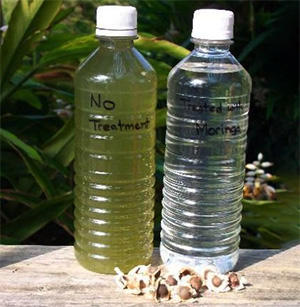
Just crush some Moringa seeds, to purify your water. It will kill bacteria and make drinking safe without adding any chemicals.
The seed powder can also be used as a simple and effective method to clean a river as a whole. The powder binds in the water with solids and sinks in the process to the bottom which eliminates bacteria.
If you don’t know how much to use, just try on a small vessel.
Food
First you have to know that you can consume almost every part of this tree from the leaves and pods all the way down to the seeds.
Experts have concluded that this tree could end world hunger and it’s already working hard to do just that in many dry places on Earth.
The plant can be used as feed for animals, too. It improves the flavor of chicken eggs with a rich colored yolk, helps cattle gain weight faster and may even increase their milk production.
This is the type of feed you want for animals, especially if you are a prepper like me, seeking to make the most of all the resources you have available.
The leaves have a protein content of 28%, putting them on equal level with, for example, milk and cheese, and you can choose to eat them in a variety of ways. You may bake, juice, eat it raw, or steam it.
Just remember the longer you cook them the more you lose nutrients.
Moringa pods look like green beans and can also be consumed in the same way.
You may choose to steam, fry, or boil them. Unlike several other vegetables, you want to make sure the pod is fresh, and you’re not going to have to eat old, fibrous pods. They are hard to eat, so they don’t taste as good.
Snap them while testing the pods and if they do so quickly then they’re perfect for feeding. If not, don’t eat them because they are definitely going to be hard to chew.
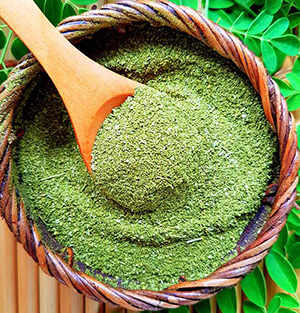
Moringa seeds can be boiled or you can sauté them. The only thing to watch out for is to not eat too much of them as they are a cleanser.
It will “clean out” your digestive system which is good but only if you don’t overdo it.
Moringa powder is a very popular form of eating this plant and it’s also the most versatile.
You can add it to juices; baked goods; and pretty much any other dish you can imagine.
Health Benefits
The Moringa will aid you with everything from safe skin to reducing oxidative stress in your body. Only when you look at the leaves do you see that they contain very high quantities of a protein, significant amounts of vitamin B6, vitamin C, iron, riboflavin, and magnesium.
Related: How to Use Herbs and Make Your Own Cold Medicines at Home
Increased Energy
A single Moringa serving contains approximately three times the spinach iron. Iron is important for blood enrichment, life carriage, strength and oxygen in your muscles, organs and tissues.
Healthy bowel movements
Moringa oils and fiber have a detoxifying effect to help clean your intestine from waste and contaminants, helping you to absorb nutrients from the food you consume completely. Especially when food is scarce this is important for survival.
Clear vision and improved eye health
Rich in beta-carotene and vitamin A, Moringa helps good vision and healthy eyes.
Stabilizes Blood Sugar Levels
The seeds contain zinc which is a required component of insulin production within your body. Using moringa seeds will give you the zinc you need to build up your insulin production and control your blood sugar. It would be especially beneficial in a crisis for diabetics or prediabetes, when their stock of synthetic insulin runs out.
Fights Inflammation
Inflammation is how the body responds to an injury or infection.
It’s fine for a while but if it persists it can lead to chronic health issues like heart disease and cancer.
Moringa can combat inflammation of the body by means of the isothiocyanates found in its leaves, pods and seeds.
Lowers Cholesterol
Nowadays, cholesterol is a big concern and one of the major causes of heart disease. It has been found that the moringa tree reduces the bad cholesterol levels.
Improves Skin Health
This plant’s seeds contain an oil which can be used as a moisturizer to the skin. These do contain antioxidants, and they have anti-inflammatory properties which are the building blocks of healthy skin.
How to Grow Moringa?
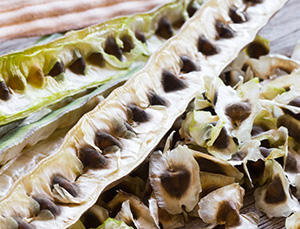
You essentially have two choices when growing moringa: growing from seed or growing from cutting.
You’ll want to choose a spot with some dry, light soil when developing from seed. Screw a very large hole and add some manure. Next, put about five (not too deep) seeds in it and cover them with soil. Water them in the end but don’t overdo it, because it may cause rotting.
It’s a little better if you choose to go with using a plant break. Get a roughly six feet long cut. Then dig a hole inside the earth. Place the cutting in the hole and place on a sand mixture, manure. When watering, aim to get it just around it on the field and not directly on the new plant’s stem.
Moringa is a very strong plant as you can probably see by now. It has many benefits and more are discovered annually. Yet, does Moringa make a good addition to your preps? What do you think?


